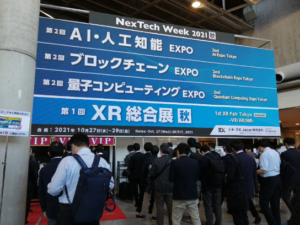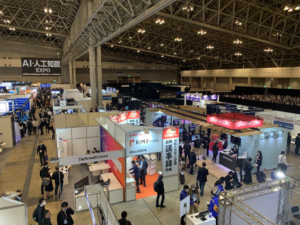2022.Feb.24
REPORTSReport on a Visit to the 2nd Artificial Intelligence Exhibition & Conference (Autumn)
Atsuko Sano; Kayoung Kim (Project Researcher of the B’AI Global Forum)
・Date: Friday, October 29, 2021
・Venue: Makuhari Messe, Chiba Prefecture, Japan “The 2nd Artificial Intelligence Exhibition & Conference”
・Visiting members: Atsuko Sano, Kayoung Kim
The BʼAI Global Forum is a research group dedicated to the development of Artificial Intelligence (AI) and other digital technologies to achieve a gender equal society that guarantees minority rights. We are always trying to find out whether there are any disadvantageous factors for minorities from a gender perspective, or in other words, whether there are any demerits for minorities and what should be done to prevent them, while the introduction of AI is progressing mainly in male-dominated economic activities and ICT technology fields. We often look critically at the progress of the digital society.
 On Friday, October 29th, 2021, members of the B’AI Global Forum visited the 2nd Artificial Intelligence Exhibition & Conference Autumn (AI EXPO) at Makuhari Messe in Japan. In this report, we would like to share some of the examples we found at the EXPO and what we noticed in relation to the points we usually discuss in the B’AI Global Forum.
On Friday, October 29th, 2021, members of the B’AI Global Forum visited the 2nd Artificial Intelligence Exhibition & Conference Autumn (AI EXPO) at Makuhari Messe in Japan. In this report, we would like to share some of the examples we found at the EXPO and what we noticed in relation to the points we usually discuss in the B’AI Global Forum.
1. Positive examples of AI utilization
The event is held twice a year and allows visitors to learn directly about practical examples of AI applications at business sites and cutting-edge laboratories. There were also several exhibitors from universities and students, as they can promote their R&D and products and gain opportunities for networking and entrepreneurship.
(1) Detection of child abuse
This is a system to support child guidance centers’ countermeasures against the abuse by using AI. In collaboration with Mie Prefecture, a platform has been developed based on the analysis of data on approximately 6,000 cases of child abuse handled by child guidance centers in Mie Prefecture over a six-year period from 2013 to 2018.
(National Institute of Advanced Industrial Science and Technology (AIST): Development of Child Abuse Response and Decision Making Support System Employing AI)
(2) Dialogue system with elderly people who need care
With a spoken dialogue system using big data, a robot in the shape of a stuffed dog interacts with elderly people to check their health conditions. In addition to spoken dialogue, the robot can also respond to the elderly person’s facial expressions and gestures. For example, when the AI detects that the elderly person’s expression has clouded over, the robot will respond by saying, “I’m sorry for asking you this question so suddenly.”
The system was developed with the aim of checking health conditions and daily habits on behalf of care managers, the shortage of whom is a concern due to the aging population and declining birthrate. Moreover, the system is expected to respond to the situation that the opportunities for face-to-face contact have been reduced in the COVID-19 pandemic as communication is crucial in maintaining the health of the elderly.
(National Institute of Information and Communications Technology (NICT): Multimodal Spoken Dialogue System “MICSUS” for the Elderly)
(3) Disaster management chatbot
This is a chatbot running on smartphones or similar devices, designed to collect disaster information, cope with fake information, and improve the efficiency of the rescue operations.
Linked to LINE, Weathernews, etc., it automatically interacts with a large number of disaster sufferers. The system will also prevent the spread of disinformation, which can lead to confusion in the case of a disaster. For example, when the system receives information about a landslide, it asks the people on the ground whether the information is true or not, and reconfirms its accuracy.
(National Institute of Information and Communications Technology (NICT): Disaster prevention chatbot (SOCDA) )
There were other booths showing various services related to AI, although not directly utilizing it. Among them, the following is an example of how the transition to an AI society can lead to women’s empowerment.
(4) Outsourcing service of AI training data creation
Deep learning and machine learning used in AI make use of big data, yet the issue is how to reduce the time required to process large amounts of data and the heavy load on PCs. For this reason, recently there have been approaches to use a small amount of high-quality data to make predictions (as accurately as possible) by deep learning, as well as to speed up the process.
There was a booth introducing a service that undertakes the creation of this high-quality data (training data) by utilizing a network of home-based workers, many of whom are women. The company providing this service has a corporate philosophy of “connecting women’s careers with society” and promotes new work styles such as re-employment and entrepreneurship for women who have left the workforce due to life events.
(Career Mam AI Training Data Creation Outsourcing (Japanese))
2. Issues and concerns
 This section will then describe the insights gained from the exhibition in relation to three themes that frequently appear in discussions within the B’AI Global Forum: (1) ethics related to AI, (2) impacts of efficiency, and (3) respect for diversity.
This section will then describe the insights gained from the exhibition in relation to three themes that frequently appear in discussions within the B’AI Global Forum: (1) ethics related to AI, (2) impacts of efficiency, and (3) respect for diversity.
(1) Ethics related to AI
With the rapid progress of digitalization and the development and introduction of AI in recent years, ethical frameworks for the development and use of AI have been discussed worldwide. In Japan, the Cabinet Office has published the “Social Principles of Human-Centric AI.” In response to these trends, how are the sites of research and development actually moving along?
There was a report that the RIKEN Center for Advanced Intelligence Project (AIP) is paying attention to the diversity of human resources and conducting basic research to mathematically explain deep learning because it does not know why it works. The Center for Information and Neural Networks (CiNet), which is working on neuroscience technology research, shared their research on brain stimulation and recording using invasive and non-invasive methods (https://cinet.jp/english/research/overview.html), but also mentioned that there are ethical issues comparable to the human genome. On the other hand, in the exhibition space, a service combining brain wave measurement and AI created by an Israeli company attracted a lot of attention.
(2) AI as a tool for efficiency
It is said that women’s unemployment will occur as digitization and AI are introduced (Schwab Kraus=World Economic Forum 2016:63-65 see:https://nikkeibook.nikkeibp.co.jp/item-detail/32111). This is because AI will replace tasks in which a large percentage of women are employed. The International Monetary Fund (IMF) estimates that the risk of the unemployment rate of Japanese women is about 3.4 times of that of Japanese men, and it is the largest gender gap among the 30 countries surveyed. IMF also pointed out that the risk gap between men and women tends to widen in countries where women are more likely to work in routine jobs. such as clerical work taken over easily by AI (https://www.nikkei.com/article/DGXMZO50297000X20C19A9000000/). Reskilling (relearning) for IT workers is also being discussed in view of The Future of Work, which shows what kind of jobs will be in demand in the future (see: Study Group on Human Resource Policy in the Digital Age).
How do companies plan to deal with the risks that lie behind this increasing efficiency in the workplace?
At AI EXPO, Professor Yutaka Matsuo of the University of Tokyo gave a lecture titled “‘DL for DX’: The Frontline of AI (DeepLearning) Application in the DX Age” that suggested a direction for companies in the AI era. Professor Matsuo said that Japan is only following the global trend of 20 years ago and is lagging behind. According him, the essence of DX is to increase profits by speeding up the development cycle, not by increasing the principal through launching new products, as the way companies have done in the past. Then, he said, it is important to change the entire industry so that it can move faster. In other words, the organizational culture should be changed so that the PDCA cycle can be accelerated, or rather, the cycle can be faster by allowing people to make mistakes earlier, gaining experience from them, and speeding up the process. This requires an open-minded, diverse, and flat organizational structure that can tolerate failure, as well as human resource cultivations that can act as a turbo to increase the turnover rate.
Overall, the impression was that AI will fundamentally change the way we think about corporate management. However, if AI is being developed mainly for the purpose of improving efficiency and also increasing the turnover rate, the question remains whether the response to women’s unemployment will be able to keep up with the speed.
(3) Respect for diversity
Diversity is one of the crucial keywords when discussing the ethics of AI. Regarding gender issues, the Fifth Basic Plan for Gender Equality and the Sixth Basic Plan for Science, Technology and Innovation in Japan have set a goal to increase the percentage of women researchers from the viewpoint of increasing diversity in the R&D process.
One of the lectures I attended at AI EXPO referred to the ratio of foreign nationals and women, indicating that diversity is being focused on in the R&D field. However, there were moments when we were concerned that the unconscious bias of developers against women might be strongly influenced in the system. For example, the AI-based English learning support system used an illustration of a female character wearing a swinging earring.
Such a depiction of a woman reminded us of the case of Takanawa Gateway Station, in which a dialogue using AI was criticized as sexual harassment. In this case, the AI character of a female station attendant was given a gesture of touching her hair. The majority of the participants at the exhibition were men, giving also a strong impression that the AI business is a male-dominated market.
- Review
International discussions and policies have been focusing on respecting ethics and increasing diversity in AI development. However, as far as we can see at AI EXPO, it seems that the utilization and implementation of AI is ongoing without much awareness of these issues in the field of business and research. In such a situation, if the focus is on increasing profits by speeding up the PDCA cycle, development may proceed without including diverse perspectives, and the unconscious bias of a few developers may be reinforced, which will ultimately have a negative impact on minorities.
However, when we individually talked to people in the hall, some of them were aware of the importance of respecting ethics and promoting diversity within the industry. Although there seems to be a deep-rooted unconscious bias in the development field, it seems that the way to an AI society that is win-win for both business and minorities will open up if we consciously include improving diversity such as gender equality into the organizational and system reforms to be ready for globalization.